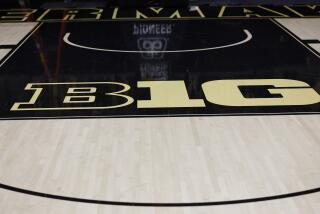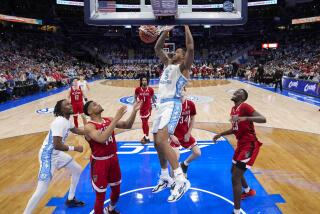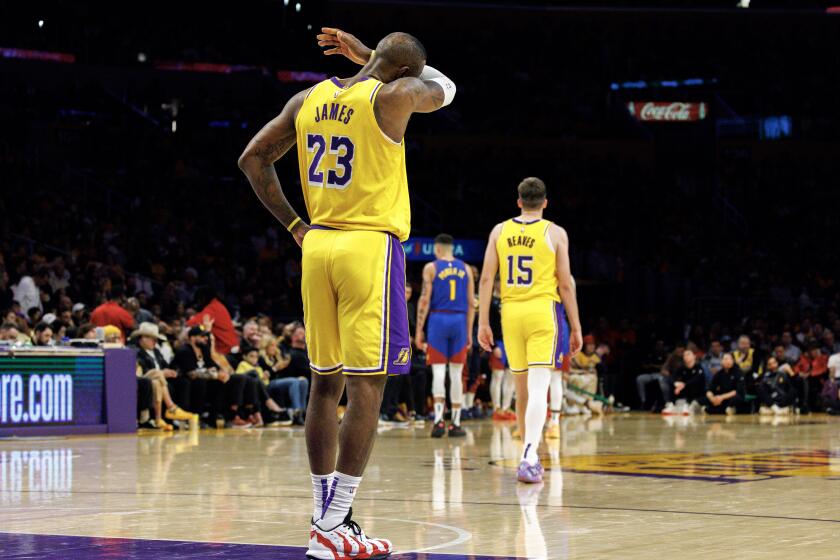NCAA tournament bracketology is a whole new course now
The Oregon “Tall Firs” posed for the first NCAA championship photograph dressed in suits and ties.
Everything was black and white then.
Bobby Anet, who scored 10 points in the 46-33 win over Ohio State, cradled the trophy in his lap.
The year was 1939.
Man, are those gone-with-the-wind days.
There are now more members on the NCAA selection committee (10) than schools (eight) involved in the first tournament.
Committee members have been huddled up in an Indianapolis hotel all week surrounded by pie charts and nondairy creamer.
There was some concern that Gene Smith, this year’s committee chairman and the athletic director at Ohio State, might be distracted by the scandal involving his football coach.
Not to worry.
Smith flew back to Columbus, Ohio, slapped a two-game suspension on Jim Tressel for a major violation, and then made a Clair Bee line to Indianapolis for the important work at hand.
Smith is commanded to leave the room whenever his top-ranked basketball team is discussed, a rule he extended with reporters regarding his football team.
“We’re here to talk about the basketball tournament,” Smith said on a teleconference Wednesday.
Is there anything, at this time, more important?
This year’s bracket has been expanded to 68 schools, the latest tweak to accommodate America’s insatiable appetite for more.
The “principles and procedures for establishing the bracket” alone will cost you seven pages on your home printer.
Each of “the first three teams selected from a conference shall be placed in different regions.”
Teams “will remain in or as close to their areas of natural interests as possible.”
There “shall not be more than two teams from a conference in one region.”
The pressure to get things picture-bracket-perfect for Selection Sunday intensifies as the sport embarks on a 14-year, $10.8-billion deal with CBS and Turner Sports.
It’s madness, all right.
The first NCAA tournament lost $2,531.
The decision to expand to 68 schools this year was controversial, a compromise to the eventual leap toward 96, which is someday going to happen.
Three extra scoops of ice cream sure makes more symmetrical sense than the “65” flavors they’ve been selling us since 2001.
The Tuesday “play-in” game in Dayton, Ohio, was added after the Mountain West became a conference and earned an automatic berth. Not wanting to eliminate one of the “at-large” spots, the NCAA expanded the field to 65, with the two worst teams having to play each other for the last spot.
The new format increases the “at-large” pool by three and removes the stand-alone stigma of the play-in game.
There will now be four games in Dayton, on Tuesday and Wednesday. Two will pit the last four “at-large” schools selected in the field. For the first time, they will be indentified. These will likely be mid-finishers from major conferences with the play-in winners likely slotted into No.11 or No. 12 seeding spots.
Two other Dayton games will match four champions from the lowest-rated conferences with automatic-bid status. Those two winners will be fed into No. 16 seeding positions.
In terms of your office pools, don’t panic. This actually makes far more sense in filling out your bracket than having to account for one “play-in” game. The NCAA can much more effectively sell the “First Four” as a legitimate entry point into the round of 64.
That’s not to say there won’t be arguments.
“This is March Madness,” Smith said. “Whether it’s the first four or the first eight at the top of the bracket, people are going to analyze, they’re going to debate, be excited … disagree. That’s part of what this is, part of what we’re blessed to serve.”
College basketball has become, by design, almost hopelessly money hungry and back ended, rendering the regular season as laconic as the postseason is lunatic.
The sport long ago sold its December soul for the riches of March … but what a financial windfall for Jim Nantz.
The four weeks starting with this week’s conference tournament are, arguably, the most exciting in sports.
Brigham Young star Jimmer Fredette scored 52 points Friday night in Las Vegas, only 17 fewer points totaled by Penn State and Wisconsin in a 36-33 sleeper.
Conference tournaments, for all their circus qualities, come with a price.
Those who argue college basketball is superior to football in solving its championship are certainly correct, but handing the automatic bid to the conference tournament champion is hardly “fair.”
Before 1975, only one representative from each conference was allowed in the field. The tournament was 32 teams then, and several expansions led to the field of 64 in 1985.
Today, a school with a losing record, with a hot streak in its conference tournament, can knock the regular-season champion out of the NCAA field.
Long Beach State (22-11) dominated the Big West Conference this season but will be left home because UC Santa Barbara (18-13) beat the 49ers Saturday night in the conference tournament.
Tournaments entertain the masses at the expense of injuries and exhaustion.
Connecticut, already a cinch to make the NCAA field as an at-large team, was forced to play five consecutive days last week en route to its run to the Big East Conference tournament final.
Asked whether he had ever played this much basketball, Connecticut star guard Kemba Walker said, “No, not other than AAU.”
St. John’s, also already in the NCAA field, suffered a huge blow to its chances when D.J. Kennedy tore a knee ligament during the team’s loss to Syracuse.
“It’s going to be devastating,” St. John’s star Dwight Hardy said of Kennedy’s injury.
Duke held its collective breath after star guard Nolan Smith injured his left foot during an Atlantic Coast Conference tournament that will have little bearing on the Blue Devils’ NCAA seeding.
The NCAA committee factor injuries into the seeding process, which is why some schools refuse to release information prior to Selection Sunday.
How important are conference tournaments in terms of NCAA success?
Since the tournament field expanded in 1985, nine schools have gone on to win the NCAA championship without winning their conference tournament. And five of the champions didn’t even have a conference tournament.
North Carolina, in fact, might not want to win the ACC tournament again.
The Tar Heels earned national titles in 1993, 2005 and 2009 after someone else hoisted the ACC tournament trophy.
Cincinnati Coach Mick Cronin, incredibly, said he was glad his team got blown out by Notre Dame last week.
“I would rather go into the NCAA tournament this way than winning the Big East tournament. … It’s better to get home and get rested,” he said. “I say that because our team is better after a loss.”
To paraphrase Vince Lombardi, losing the Big East isn’t everything … it’s the only thing.
A lot has changed since 1939.
Dorothy wouldn’t recognize Kansas anymore.
twitter.com/dufresnelatimes
More to Read
Get our high school sports newsletter
Prep Rally is devoted to the SoCal high school sports experience, bringing you scores, stories and a behind-the-scenes look at what makes prep sports so popular.
You may occasionally receive promotional content from the Los Angeles Times.







